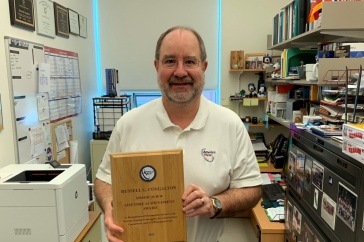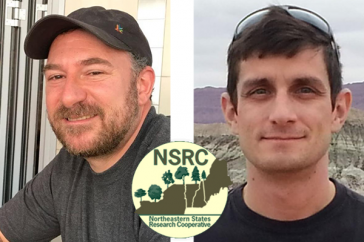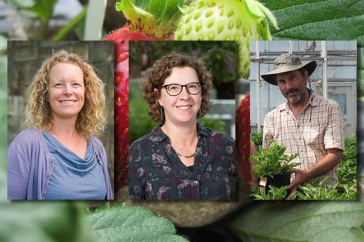
Bees are essential for most of the fruit and vegetable crops produced in New England. The value of pollination to agriculture is estimated at more than $200 billion a year worldwide. However, the abundance of and diversity of pollinators are declining in landscapes across the United States.
At the New Hampshire Agricultural Experiment Station at the University of New Hampshire, scientists are conducting research that not only assesses the state of our native bees but also developing ways that citizens can help support these important members of our ecological and agricultural communities.
For several years, experiment station researchers have been assessing the status of the state’s native pollinators. In the first ever assessment of New Hampshire’s bee population, scientists found that the Granite State has more than 100 native bees. They even discovered nearly 20 bee species that had not been previously documented in the state. The White Mountain National Forest alone is home to nearly 140 species of native bees, including two species of native bumble bees that are in decline in the Northeast.
Unfortunately, scientists also have discovered that three of the state’s most important bumble bee species have experienced drastic declines and range constriction over the last 150 years, with a fourth bee also in significant decline. In addition, scientists found that 14 wild bee species also are in drastic decline in New Hampshire.
Despite the declines, landowners, property managers, farmers, and landscapers have been eager to create and enhance pollinator habitat. “The interest in helping pollinators has been astounding. There are literally hundreds of pollinator gardens and habitats that have been installed in New Hampshire alone in the last few years,” experiment station researcher Cathy Neal said.
Neal, who also is a nursery and landscape horticulture state specialist with UNH Cooperative Extension, has conducted nearly 10 years of wildflower meadow trials at the experiment station’s Woodman Horticultural Research Farm. She has found that wildflower meadows comprised of a mixture of herbaceous perennials such as golden rod, asters, black-eyed Susans, bergamot, coneflowers and potentially many more, are extremely valuable places for bees to forage for food. In fact, she has developed a mix of wildflowers specifically ideal for New Hampshire.
Those interested in creating a wildflower meadow to support New Hampshire’s native pollinators can learn more at the upcoming field day “Connecting the Dots for Pollinator Conservation: Wildflower Meadows and Pollinator Habitat.” The event is Tuesday, July 30, 2019, from 8:30 a.m. to noon at the New Hampshire Agricultural Experiment Station’s Woodman Horticultural Research Farm, 70 Spinney Lane, Durham. It is free and open to the public.
And if you’d like to give your bees a bit of luxury, build a bee hotel or bee box nest. It doesn’t have to be as elaborate as the UNH Bee Hotel. According to Neal, when constructing nest boxes, it is important to remember that there are many types of bees, and providing cavities in a mix of sizes can help accommodate a wide diversity of bee species.
This material is based upon work supported by the NH Agricultural Experiment Station, through joint funding of the National Institute of Food and Agriculture, U.S. Department of Agriculture, under award number 1004515 and 1010449, and the state of New Hampshire.
Founded in 1887, the NH Agricultural Experiment Station at the UNH College of Life Sciences and Agriculture is UNH’s original research center and an elemental component of New Hampshire's land-grant university heritage and mission. We steward federal and state funding, including support from the USDA National Institute of Food and Agriculture, to provide unbiased and objective research concerning diverse aspects of sustainable agriculture and foods, aquaculture, forest management, and related wildlife, natural resources and rural community topics. We maintain the Woodman and Kingman agronomy and horticultural research farms, the Macfarlane Research Greenhouses, the Fairchild Dairy Teaching and Research Center, and the Organic Dairy Research Farm. Additional properties also provide forage, forests and woodlands in direct support to research, teaching, and outreach.
-
Written By:
Lori Wright, '06G | NH Agricultural Experiment Station | lori.wright@unh.edu | 16038621452



















































